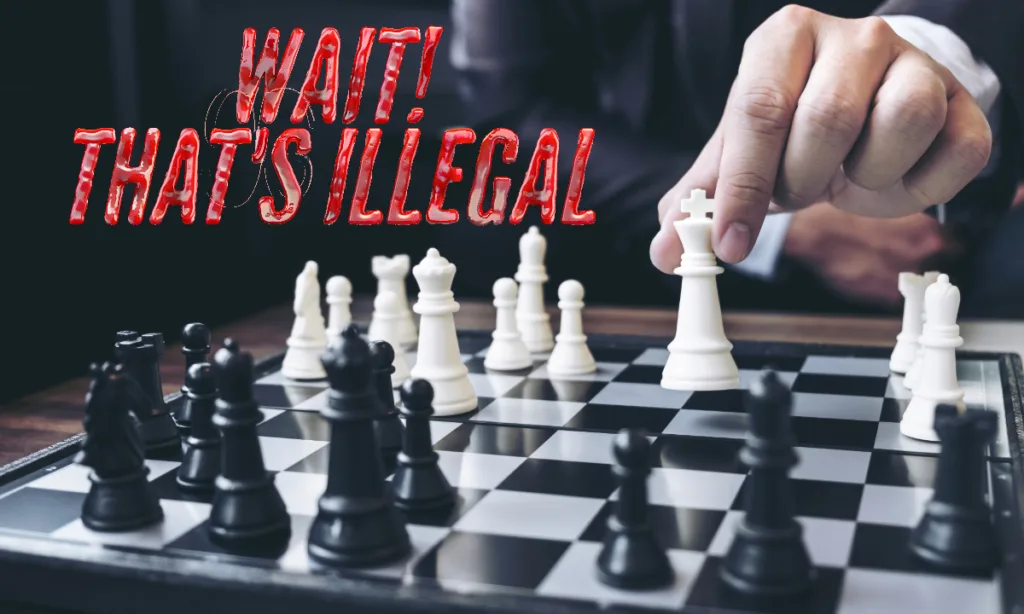Chess is a game of infinite possibilities—well, almost. For all the creativity you can bring to the board, there are some hard-and-fast rules that simply cannot be broken. When you make an illegal move, it’s like trying to sprint through a wall. You don’t get anywhere, and it’s probably not going to end well for you.
But what exactly counts as an illegal move, and what happens when you make one? Let’s dive into the rulebook and figure out where the line is—and what happens when you step over it.
What Is an Illegal Move?
An illegal move is any action that breaks the established rules of chess. These aren’t suggestions—they’re the immutable laws of the game. You can’t just put your bishop on a square it can’t legally reach, or leave your king in check like, “Eh, it’s fine.”
Illegal moves can be unintentional (a slip of the hand or a miscalculation) or downright cheeky (yes, people have tried to sneak in moves they know aren’t allowed). Either way, it’s not a good look.
Common Illegal Moves
1. Moving Into Check
The golden rule of chess: The king must never be in check. Moving your king into a square where it can be captured is like voluntarily jumping off a cliff—it’s just not a smart move.
2. Ignoring a Check
When your king is under attack, you have three options: move the king, block the attack, or capture the attacking piece. Doing anything else while your king is in check is illegal. You can’t just pretend it’s not happening.
Read more: Can the King Attack in Chess?
3. Pawn Promotion Gone Wrong
When a pawn reaches the opposite end of the board, it must be promoted to a queen, rook, bishop, or knight. You can’t leave it as a pawn. And no, you can’t invent a new piece like “super bishop” or “mega knight.”
4. Two-Handed Castling
Castling is the only time you move two pieces in one turn, but it has to be done in a single, smooth motion. Touching the rook and king with both hands is not only illegal—it’s practically begging for side-eye from your opponent.
5. “Oops, My Bishop Teleported”
A bishop can only move diagonally. If you plop it down on a square it can’t legally reach, congratulations—you’ve entered the realm of the illegal.
6. Touch-Move Violations
In over-the-board chess, the touch-move rule is sacred. If you touch a piece, you must move it, as long as it has a legal move. Touching a piece and then saying, “Just kidding!” is strictly against the rules.
7. Improper En Passant
The en passant rule is already confusing enough. But if you try to capture a pawn en passant when it’s not eligible, that’s illegal. And probably a little embarrassing.
What Happens When You Make an Illegal Move?
The consequences of an illegal move depend on the setting:
- Friendly Games: Your opponent will likely point out the mistake, and you’ll simply take it back. No harm, no foul—though you might owe them a coffee.
- Tournaments: Things get serious here.
- First Illegal Move: Usually, you’ll get a warning and have to make a legal move instead.
- Second or Third Illegal Move: Many tournaments will declare you the loser immediately. Yes, it’s that strict.
- Blitz and Rapid Games: If you make an illegal move, your opponent can claim an instant win. Blitz players are ruthless about this—don’t say you weren’t warned.
Famous Illegal Move Moments
During the 2017 World Blitz Championship, Ernesto Inarkiev and Magnus Carlsen found themselves in a highly unusual situation. In their blitz game, Carlsen checked Inarkiev’s king. Instead of addressing the check, Inarkiev ignored the check and played a counter-check—a move that is completely illegal in chess. Yes, you read that right: YOU CAN’T DO THAT.
Amazingly, Carlsen didn’t stop the game to call out the illegal move. Instead, he simply moved his king as if nothing had happened. At this point, Inarkiev stopped the clock, called the arbiter, and tried to claim the win for himself. Bold, isn’t it?
Fortunately, justice prevailed. The arbiter reviewed the situation and awarded the win to Carlsen. But Inarkiev’s actions sparked controversy. Was it gamesmanship? A moment of opportunism? Or just poor sportsmanship?
How to Avoid Illegal Moves
1. Double-Check Before You Move
Before you let go of that piece, take a second to make sure it’s a legal move. This tiny pause can save you a lot of embarrassment.
2. Learn the Rules
Understanding niche chess rules like en passant and castling requirements can prevent mistakes. If you’re not sure about something, look it up before your next game.
3. Play Slowly (When You Can)
In slower time controls, you have the luxury of thinking things through. Blitz is exciting, but it’s also where illegal moves thrive.
Why Illegal Moves Matter
Illegal moves aren’t just rule violations—they’re a reminder of the precision and structure that make chess so compelling. Without these rules, chess would devolve into chaos. Can you imagine someone trying to “triple jump” their rook across the board? No, thank you.
Every illegal move is an opportunity to learn. Whether it’s a casual game or a high-stakes match, understanding the boundaries of chess makes you a stronger, sharper player.
So the next time you’re tempted to do something questionable on the board, remember: It’s chess, not improv. Stick to the script, and you’ll be fine.
I’m the senior editor of Attacking Chess, a keen chess player, rated above 2300 in chess.com. You can challenge me or asking questions at Chess.com.

